
Hemaris gracilis, the slender clearwing or graceful clearwing, is a moth of the family Sphingidae. The species was first described by Augustus Radcliffe Grote and Coleman Townsend Robinson in 1865.
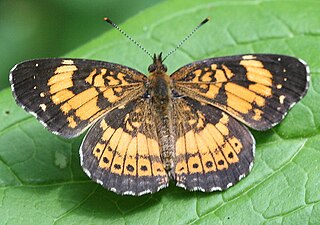
Chlosyne nycteis, the silvery checkerspot, is a species of Nymphalinae butterfly that occurs in North America. It is listed as a species of special concern in Connecticut and Maine, and is believed extirpated in Connecticut, Massachusetts, and New Hampshire.

Acronicta lanceolaria, the lanceolate dagger moth or pointed dagger, is a moth of the family Noctuidae. The species was first described by Augustus Radcliffe Grote in 1875. It is found in North America, from Nova Scotia to British Columbia. It is listed as a species of special concern and believed extirpated in the US state of Connecticut.

Lithophane lemmeri, Lemmer's noctuid moth or Lemmer's pinion, is a moth of the family Noctuidae. It is found in the eastern parts of the United States and adjacent areas in Canada. It is listed as a species of special concern in the US state of Connecticut. The species was first described by William Barnes and Foster Hendrickson Benjamin in 1929.

Argyrostrotis anilis, the short-lined chocolate, is a moth of the family Noctuidae. The species was first described by Dru Drury in 1773. It is found in North America from Quebec and Ontario, down through the eastern United States to Florida and Texas. It is listed as a species of special concern in the state of Connecticut.

Acronicta fragilis, the fragile dagger moth, is a moth of the family Noctuidae. The species was first described by Achille Guenée in 1852. It is found in North America from Newfoundland to Florida, west across Canada, south to Kentucky and Minnesota. It is listed as a species of special concern in the US state of Connecticut.

Acronicta falcula, the corylus dagger moth, is a moth of the family Noctuidae. The species was first described by Augustus Radcliffe Grote in 1877. It is found in the United States and Canada from southern New England to southern Manitoba and Iowa. Recently seen from Wisconsin, Connecticut, Rhode Island, New York and Michigan. It is reported as rare in Ohio. It is listed as a species of special concern in the US state of Connecticut.

Erynnis horatius, commonly known as Horace's duskywing, is a species of butterfly in the family Hesperiidae. It is found in the United States from Massachusetts to Florida, and west to eastern South Dakota, the Gulf Coast, south-eastern Utah, Colorado, north-eastern Arizona, and New Mexico. It is listed as a species of special concern in the US state of Connecticut.
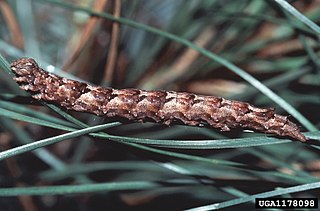
Zale submediana, the gray spring zale, is a moth of the family Noctuidae. The species was first described by Embrik Strand in 1917. It is found in the US from Wisconsin to Maine, south to New Jersey and in mountains to North Carolina.
Melitara prodenialis is a moth of the family Pyralidae described by Francis Walker in 1863. It is native to North America, where it is known from south-eastern New York to Florida along the Atlantic coastal plain, and west to eastern Oklahoma and north-central and south-eastern Texas. It is an introduced species in Hawaii. It is a special concern species in Connecticut.
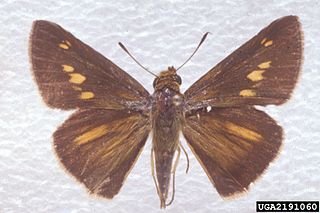
Euphyes dion, the Dion skipper or Alabama skipper, is a species of butterfly of the family Hesperiidae. It is found in scattered populations along the Atlantic coast of North America, from western Massachusetts and south-eastern New York south to north-eastern Florida, west to north-eastern Texas, and north to south-eastern North Dakota, northern Wisconsin, southern Ontario and southern Quebec. It is listed as a species of special concern in the US state of Connecticut.
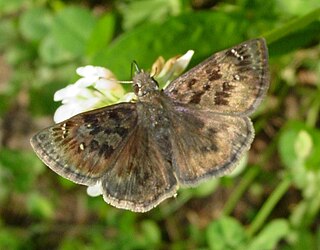
Erynnis martialis, commonly known as the mottled duskywing, is a species of butterfly in the family Hesperiidae. It is found in most of the eastern United States and in southern Ontario, and southeastern Manitoba. It is listed as a species of special concern and believed extirpated in the US state of Connecticut.
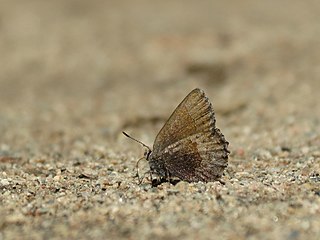
Callophrys polios, the hoary elfin, is a butterfly of the family Lycaenidae. It has a very local distribution in the United States from Maine south to New Jersey and in the Appalachian Mountains to Virginia, west across the Great Lakes states and the southern prairie provinces and north to Alaska. Along the Pacific Coast it is found to northern California and in the Rocky Mountains south to northern New Mexico. It is listed as a species of special concern and believed extirpated in the US state of Connecticut.
Apodrepanulatrix liberaria, the New Jersey tea inchworm, is a moth in the family Geometridae. It was described by Francis Walker in 1860. It is found from extreme southern Quebec and southern Ontario southward into northern Florida and Mississippi. It is listed as endangered by state authorities in the US states of Massachusetts and Connecticut.

Glena cognataria, the blueberry gray moth, is a moth native to North America. It ranges from Florida to Nova Scotia and New Brunswick. Its larvae is hosted on blueberry. The habitat consists of bogs and pine barrens. It is listed as a species of special concern and believed extirpated in the US state of Connecticut.
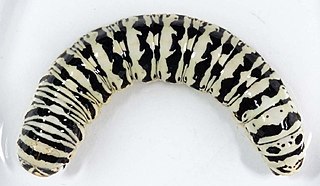
Cucullia speyeri, common names Speyer's paint, Speyer's cucullia or Speyer's hooded owlet moth, is a moth found in North America. It is found from Alberta and Montana to the Atlantic coast from New Hampshire to Virginia. It was described by Joseph Albert Lintner in 1874. In the US state of Connecticut, it is listed as a species of special concern and is believed to be extirpated. The habitat consists of open meadows, dry grasslands and native prairies.
Hydraecia immanis, the hop vine borer moth is a moth in the family Noctuidae native to North America. The species was described by Achille Guenée in 1852. It is listed as a species of special concern and is believed to be extirpated from the US state of Connecticut.

Sideridis maryx the maroonwing moth, is a species of moth native to North America. In the US state of Connecticut, it is listed as a species of special concern and is believed to be extirpated. The larval food plant is unknown, but it is suspected to be a specialist feeding on Arctostaphylos uva-ursi. The species was first described by Achille Guenée in 1852.
Apamea lintneri, the sand wainscot moth, is a species of moth native to North America. It is listed as a species of special concern in the US state of Connecticut. The species was described by Augustus Radcliffe Grote in 1873.
Photedes inops, the spartina borer moth, is a species of moth native to North America. The larvae are hosted on Spartina pectinata, apparently exclusively. It is listed as a species of special concern in the US state of Connecticut.













